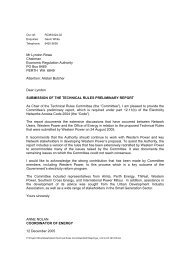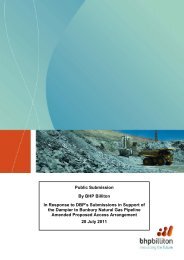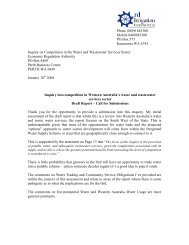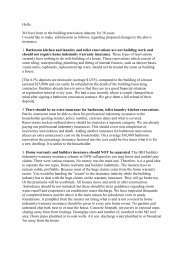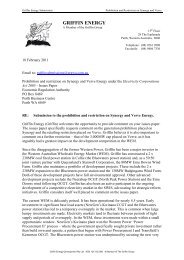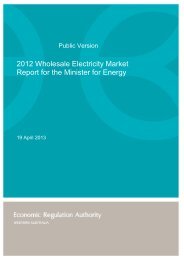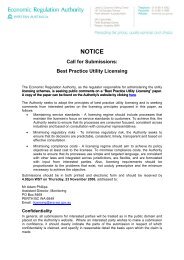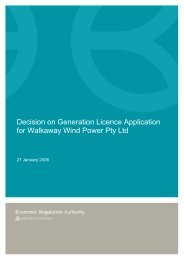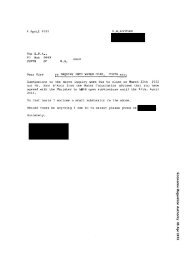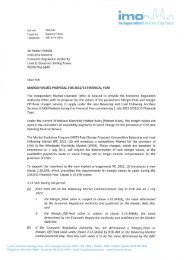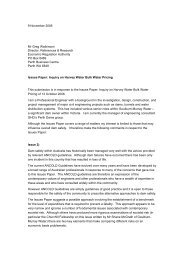Western Power Network Pricing - ERA Economic Regulation ...
Western Power Network Pricing - ERA Economic Regulation ...
Western Power Network Pricing - ERA Economic Regulation ...
Create successful ePaper yourself
Turn your PDF publications into a flip-book with our unique Google optimized e-Paper software.
Operating expenditure<br />
The Council supports the position taken by the Authority in the Draft Decision to reduce <strong>Western</strong><br />
<strong>Power</strong>’s AA3 opex allowance in its revenue proposal on the basis of the recommendations of its<br />
technical consultant, GBA. The reductions are in the range of $520m over the AA3 period.<br />
The Authority presents the results of a benchmarking study comparing <strong>Western</strong> <strong>Power</strong>’s opex<br />
efficiency performance against the State averages for five other jurisdictions (Queensland, NSW,<br />
Victoria, South Australia, and Tasmania). 5 GBA uses three benchmarks:<br />
<br />
<br />
Opex/km line;<br />
Opex/customer; and<br />
Opex/RAB (regulated asset base). 6<br />
The Council considers that these benchmarks are well chosen. While benchmarking has inherent<br />
limitations as noted by GBA, the benchmarks selected by GBA are simple, transparent, clear, and<br />
capable of normalisation. More importantly, they relate to key cost drivers within electricity<br />
networks. The Opex/Km Line benchmark is an appropriate benchmark as line length represents the<br />
size of the network. The size of the network is a direct influence on the size of the maintenance<br />
effort. The Opex/Customer benchmark is an appropriate benchmark as customer numbers have a<br />
direct effect on metering, connections, customer services and billing costs. The Opex/RAB<br />
benchmark is an appropriate benchmark as the RAB is the most immediate and relevant proxy for<br />
the replacement cost of the network and is a measure of the size of an electricity network. The<br />
physical size of the network drives the number of operations and maintenance activities required.<br />
Accordingly, the Council considers the opex benchmarks should be considered closely in setting the<br />
opex allowance and in determining the scope for efficiency savings over time. It is appropriate to<br />
place reasonable weight on the benchmarks and to undertake a normalisation process when<br />
comparing <strong>Western</strong> <strong>Power</strong>’s network to the interstate comparator group.<br />
When considering the results of the benchmarking it is worthwhile to note that the benchmarks<br />
would tend to favour <strong>Western</strong> <strong>Power</strong> because <strong>Western</strong> <strong>Power</strong> is compared with State average<br />
performance in these three benchmarks in each of the five comparator States. 7 The State averages<br />
include widely dispersed country areas (particularly in Queensland and NSW) where benchmark<br />
performance is reduced by the distances that service crews have to travel to maintain the network.<br />
These travel costs drive up opex and reduce performance against the benchmarks considerably.<br />
Within <strong>Western</strong> Australia, the extent of this tendency could be verified by comparing <strong>Western</strong><br />
<strong>Power</strong>’s performance against Horizon <strong>Power</strong>’s performance.<br />
5 <strong>ERA</strong> Draft Decision, table 11, p. 58.<br />
6 <strong>ERA</strong> Draft Decision, table 11, p. 58.<br />
7 <strong>ERA</strong> Draft Decision, p. 58, table 11.<br />
11




